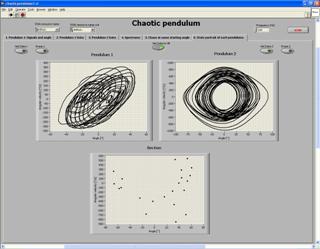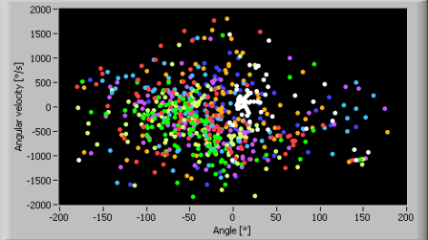Double pendulum
On this project
- Gergely Vadai - PhD Student
- Zoltán Gingl - PhD, Group leader
- János Mellár - department engineer
- Iván Gyémánt (Associate Professor, Department of Theoretical Physics)
Project
The goal of this project is to demonstrate the main characteristics of chaos, and the study methods of it on a real double pendulum.
The rotation of the upper pendulum is measured by a 3-axis accelerometer, and of the lower pendulum by a digital rotation encoder.
A bluetooth module sending the data to a PC, and the software displays the chaotic parameters and sections along with the spectacular movements.
The system demonstrates different measurement-methods, using numerical analysis and the hallmarks of the chaos like sensitive dependence to the initial conditions,
so its suitabilty in high school education. Analysing the difference between this system with friction, and the theoretical, conservative double pendulum
is an intstructive and exciting excersise for undergraduate students.
See pictures and parameters of our double pendulum
Software
The software was written in LabVIEW. It displays the following main elements:- Signals of the accelerometer, and the calculated upper angular displacements,
- The filtered upper-angle data (using Bessel-Lowpass Filter) and the calculated angular velocity,
- The lower angular displacements and the filtered data (using Bessel-Lowpass Filter) and the calculated angular velocity,
- The spectrums of the upper and lower-angle data,
- The comparison of different movements (started from near-to same initial conditions),
- The phase-portraits of the two pendula, and a phase-space section.
Measurement results
We measured 8 different movements (started from near-to same initial conditions), and after the offline synchronization, we compared them
by calculating the Ljapunov-exponents and a phase-space section.
Analysing the difference between these results and the theoretical ones, (calculated for a conservative double pendulum, chosen the appropiate energy-levels) is
a complex, but instructive problem for researchers and undergraduate students.
Our studies
[1] G. Vadai, Z. Gingl and J. Mellár, Real-time demonstration of the main characteristics of chaos in the motion of a real double pendulum, European Journal of Physics 33 907-920, 2012[2] Kettős inga kaotikus mozgásának vizsgálata virtuális méréstechnikával - Report of scientific student's circle - Gergely Vadai, 2010
[3] Kettős inga kaotikus mozgásának vizsgálata virtuális méréstechnikával - BSc Thesis - Gergely Vadai, 2010
References
Textbooks
- Tél Tamás and Gruiz Márton 2006 Chaotic Dinamics Cambridge University Press Cambridge
- Alligood, K. T., Sauer, T., and Yorke, J.A. (1997). Chaos: an introduction to dynamical systems. Springer-Verlag New York
- Hand L N and Finch J D 1998 Analytical Mechanincs, Cambridge University Press, Cambridge
Chaos theory in education
- Stavrou D, Duit R and Komorek M 2008 A teaching and learning sequence about the interplay of chance and determinism in nonlinear systems, Phys. Educ. 43 417
- Adams H M and Russ J C 1992 Chaos in the classroom: exposing gifted elementary school children to chaos and fractals, J. Sci. Edn Technol. 1 191–209
- Gruiz Márton: Érdekes kaotikus mechanikai rendszerek, 2009, FIZIKATANÍTÁS TARTALMASAN és ÉRDEKESEN Konferencia, Budapest
- Szatmáry-Bajkó Ildikó: KÁOSZT? – AZT! - Káoszelmélet a középiskolában, Fizikai Szemle 2006/11 376
Double pendulum in education
- Vankó P 2007 Investigation of a chaotic double pendulum in the Basic Level Physics Teaching Laboratory, Eur. J. Phys. 28 61
- Suzuki M, Toho M, Minato A and Ozawa S 2001 Computer Aided Education in Physics by using Double pendulum Equipment International Conference Information Technology Based High Education and Training, Kumamoto
- Békéssy László István and Bustya Áron Fizikai kettősinga vizsgálata, Fizikai Szemle 2005/5. 185
Double pendulum experiment
- Shinbrot T, Grebogi C, Wisdom J, and Yorke J 1992 A Chaos in a double pendulum, American Journal of Physics 60 491
- Levien R B, Tan S M 1993 Double pendulum: An experiment in chaos, American Journal of Physics 61 1038
- Lawrence P, Stuart M, Brown R, Tucker W and Sainudiin R 2010 A mechatronically measurable double pendulum for machine interval experiments
- Liang Y and Feeny B F 2008 Parametric identification of a chaotic base-excited double pendulum experiment Nonlinear Dyn. 52 181–97
Numerical analysis of double pendulum
- Stachowiak T and Okada T 2006 A numerical analysis of chaos in the double pendulum Chaos, Solitons and Fractals 29 417–422
- Bender C M, Feinberg J, Hook D W and Weir D J 2009 Chaotic systems in complex phase space Pramana J. Phys. 73 453-470
- Ohlhoff A, Richter PH 2000 Forces in the double pendulum, Z Angew Math Mech 80(8)517–34.
- Wolfang Christian - Double Pendulum Model software
Chaotic pendulum expeiments, remote labs
- University of Florida, Department of Physics, PHY4803L Advanced Physics Laboratory
- Marone M 2002 The Mercer online interactive chaotic pendulum Computing in Science and Engineering, 4 94-97
- The Mercer online chaotic pendulum site
Datasheets
- Freescale Semiconductor, Inc. – MMA7360L 3-axis acceleromater
- Freescale Semiconductor, Inc. - MMA73x0L Analog Output Accelerometer Evaluation Board
- Avago Technologies - AEDB-9140 Series Three Channel Optical Incremental Encoder Module with Codewheel
- Rayson Technology Co., Ltd. - Bluetooth Class 2 CSR BC4-ext module




